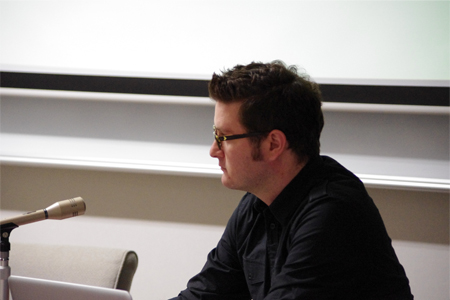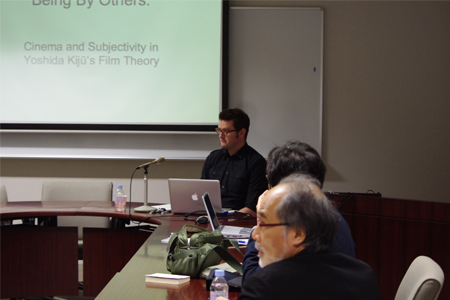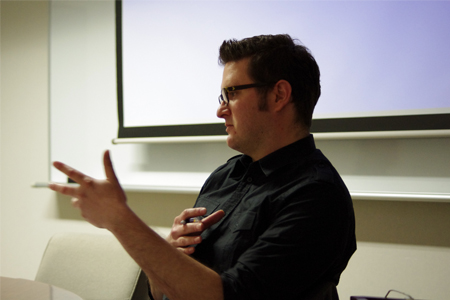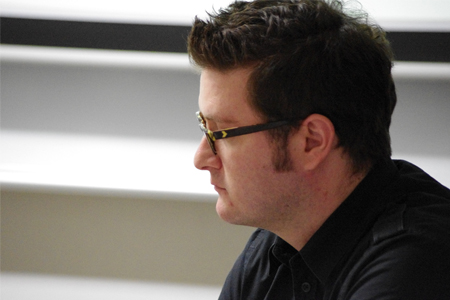[Report] Patrick Noonan, Being By Others: Cinema and Subjectivity in Yoshida Kijū’s Film Theory
On April 26, 2011, Patrick Noonan gave a talk entitled “Being By Others: Cinema and Subjectivity in Yoshida Kijū’s Film Theory”. Mr. Noonan is a doctoral candidate at the University of California, Berkeley, and this talk was based upon his dissertation research. Many young international scholars joined the lecture, and participated in a discussion following the talk.

While best known as a feature film director, Yoshida Kijū has published a substanial amount of film criticism possessing a decidedly philosophical orientation. Over a period of several decades, Yoshida has explored not only questions concerning film production, but equally the production of filmmaker and spectator. For Yoshida, cinema may be understood as a social process that creates the individuals who in turn create the cinema itself. Through a sustained reflection on this process, Yoshida grappled head-on with the formation of the consciousness of the filmmaker, both in his critical writings and in his film practice. Through a detailed analysis of several key works of criticism, Noonan draws our attention to a striking paradox in Yoshida’s reflections: namely, that the filmmaker seems to arrive at a position of authority — i.e., becomes an auteur — only by renouncing it. To dramatize this paradox, Noonan recalls Yoshida’s directorial debut at Shōchiku in 1960: Good For Nothing [Rokudenashi]. In the final sequence of this film, the protagonist succeeds in breaking with all the social ties that have oppressed him through life, but only by taking a fatal bullet. That is, he finally realizes a sense of self in the death of this same self.

Noonan argues that Yoshida’s works of the 1960s may be illuminated by his critical writings, specifically through their “rhetoric of disaffiliation”. Like Oshima Nagisa, Yoshida was promoted to the rank of studio director at the end of the 1950s, was identified with the so-called Shōchiku nouvelle vague, and left the studio after an early dispute with management over the control of his films. Yet in his critical writings of the period, Yoshida also sought to break with the image of the director incarnated in “auteurs” such as Kinoshita and Kurosawa — directors whose films, he argued, were animated by the practice of communicating a predetermined message to the audience. In place of this, Yoshida advocated an ethic of negation [hitei] or self-renunciation on the part of the filmmaker, in which the film and ultimately the filmmaker’s own consciousness would be defined by others. By focusing on the peculiarity of this stance — viz., seeking autonomy from the studio system, but simultaneously refusing the role of auteur — Noonan proposes that we interrogate its ethical dimensions and interplay with the medium of cinema.

Yoshida’s interest in rethinking the role of the filmmaker is also bound up with a desire to overturn traditional hierarchies between director and spectator. On his account, an ethical and political cinema would begin not with the politicized content of a director’s films, nor even his approach to that content (mise-en-scène, etc.), but at the deeper level of how he or she understands the basic relationship between filmmaker and spectator. On this account, a political cinema would respect the “otherness” of the spectator and his or her central role in the production of meaning. At the same time, Yoshida views this relationship as a point of conflict. Insofar as the essential character of this relationship is marked by conflict, the director is, in effect, seeking to bring it to the surface by provoking the spectator. The spectator is enjoined to break with the constraints imposed by the studio form, to enter into a new relationship with the film and, by extension, cinema itself. At issue are the cinematic codes and generic conventions of the studio film and, in particular, its conventions of storytelling and privileging of narrative movement over the cinematic image. Only by passing through this conflict, it seems, does Yoshida believe it is possible to realize new cinematic forms.

On Yoshida’s account, then, the subjectivity of the filmmaker may be understood as a form of inter-subjectivity that takes shape through a process of conflict, not only between filmmaker and spectator, self and other, and equally within each self. The ethical moment in this conflict arrives when one party allows him- or herself to be enacted or “acted upon” by the other. For Noonan, though, we should interrogate this vision of a filmmaker realized “by others”, as it equally implies a re-assertion of the filmmaker’s authority — albeit indirect — by locating spectators and the public in a relationship wherein they reinvest or reinforce the position of the filmmaker as an auteur.
Mark Roberts (UTCP Research Fellow)






